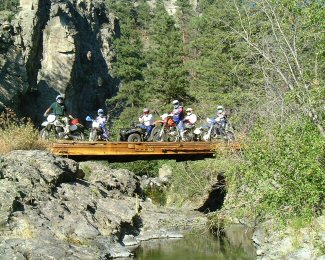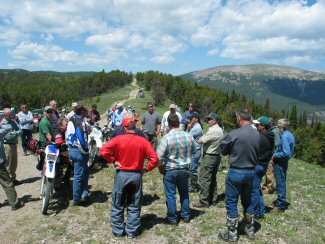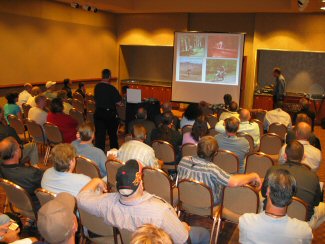| Home > Articles > How To Get Money For Your Trail Project |
How To Get Money For Your Trail Project
Millions in Federal Gas Tax Money Is Available To Those Who Ask
Steve Casper, NOHVCC Director of Communications (November 2019)Back in 1991 something happened in Washington D.C. that would turn out to be a big plus for off-highway recreation. At the time it was called the Symms Act and was named after Senator Steve Symms of Idaho who proposed in the Act that a portion of Federal gas tax money should go to off-road users (this was after a lot of hard work by OHV activist groups including the BlueRibbon Coalition). The rationale behind it was quite commonsense; if gas taxes were being used to build highways for cars and trucks, why shouldn't off-highway riders get their share (they're buying the same fuel after all!) of the taxes to pay for trail projects? The Symms Act passed and became law, much to the delight of the motorcycle and ATV world. There was a slight catch however (a percentage of the funds would have to be used for non-motorized trail projects as well), but none of us were complaining.

MANY SUCCESS STORIES
Now almost 15 years later there are dozens of ORV trail success stories thanks to the millions of dollars dispersed through the Symms Act. All-new ride areas have opened, as well as many established ones being saved and revitalized. Most of this occurred because of the efforts of the off-highway community, even though hikers, equestrians, mountain bikers, and cross-country skiers have benefited greatly as well. The trouble is, when it comes to handing out millions of dollars, the government has to make sure the right folks are getting it and that the job will be done. So it's not easy as filling out a form and sending it in to wait for a check to arrive! The task of procuring Recreational Trail Program (RTP) funds can at first appear quite daunting, but there are a group of experts whose job it is to help you along the way. Most of the off-highway successes have been through group efforts such as State and local riding clubs where you have more than one person taking on the task.
Following is an overview of the program, a description of the amount of money involved, and the steps one has to take to complete the project. We've also included a list of all the State Contacts who can help you get the ball rolling.

WHO'S IN CHARGE?
The Recreational Trails Program (RTP) is an assistance program of the U.S. Department of Transportation's Federal Highway Administration (FHWA). Each State administers its own program, usually through a State resource or park agency and each State develops its own procedures to solicit and select projects for funding. Each State has a State Recreational Trail Advisory Committee to assist with the program. In some States, the committee selects the projects. In others, the committee is advisory only.
HOW MANY MILLIONS?
Congress authorized the Recreational Trails Program for $30 million in 1998, $40 million in 1999, and $50 million annually for 2000, 2001, 2002, and 2003. Previous funding in 1996 and 1997 was $15 million each year. FHWA may use up to 1½ percent of the funds for program administration and trail related research and technical assistance. The remainder of the funds is distributed to the States. Half of the funds are distributed equally among all States, and half are distributed in proportion to the estimated amount of off-road recreational fuel use in each State--fuel used for off-highway recreation by snowmobiles, all-terrain vehicles, off-road motorcycles, and off-road light trucks.
WHAT PROJECTS ARE ELIGIBLE?
Recreational Trails Program funds may be used for:
- Maintenance and restoration of existing trails;
- Development and rehabilitation of trailside and trailhead facilities and
trail linkages;
- Purchase and lease of trail construction and maintenance equipment;
- Construction of new trails (with restrictions for new trails on Federal
lands);
- Acquisition of easements or property for trails
- State administrative costs related to this program (limited to 7 percent
of a State's funds); and
- Operation of educational programs to promote safety and environmental
protection related to trails (limited to 5 percent of a State's funds).
States must use 30 percent of their funds for motorized trail uses, 30 percent for non-motorized trail uses, and 40 percent for diverse trail uses. Diverse motorized projects (such as snowmobile and motorcycle) or diverse non-motorized projects (such as pedestrian and equestrian) may satisfy two of these categories at the same time. States are encouraged to consider projects that benefit both motorized and non-motorized users, such as common trailhead facilities. Many States give extra credit in their selection criteria to projects that benefit multiple trail uses.
WHICH PROJECTS ARE NOT ELIGIBLE?
Recreational Trails Program funds may not be used for:
- Property condemnation (eminent domain);
- Constructing new trails for motorized use on National Forest or Bureau of
Land Management lands unless the project is consistent with resource
management plans; or
- Facilitating motorized access on otherwise non-motorized trails.
I NEED A SPONSOR
States may make grants to private organizations, or to municipal, county, State, or Federal government agencies. Some States, by policy, do not provide funds to private organizations. Projects may be on public or private land, but projects on private land must provide written assurances of public access.
States are encouraged to use qualified youth conservation or service corps for construction and maintenance of recreational trails under this program.
HOW DOES IT WORK?
Project amounts vary by State, but most range in value from $2,000 to $50,000. Some States set minimum or maximum allowable dollar values.
In general, the maximum Federal share for each project from Recreational Trails Program RTP funds is 80 percent. A Federal agency project sponsor may provide additional Federal funds, provided the total Federal share does not exceed 95 percent. The non-Federal match must come from project sponsors or other fund sources. Funds from any other Federal program may be used for the non-Federal match if the project also is eligible under the other program. States also may allow a programmatic match: if some project sponsors in a State provide more match funds than required, other sponsors in the State may provide less. Some in-kind materials and services may be credited toward the project match.
HOW DO I OBTAIN RTP PROJECT FUNDING?

Each State has its own procedures to solicit and select recreational trails projects for funding. A project sponsor should develop its proposal sufficiently so that the project may move quickly into implementation after project approval.
If you have a trail project proposal, first contact your State to find out the program requirements and criteria for project selection. As a project sponsor, you should:
- Develop a workable project. What are your trail needs? What can you do
realistically?
- Get public support for your project. How does your project benefit your
community? Are there other potential project sponsors?
- Find other funding sources. The normal Federal share is limited to 80
percent. Some State or local governments may provide some matching funds, but
usually the project sponsor has to provide most or the entire match. Consider
donations of materials and volunteer labor.
- Consider how to involve youth conservation or service corps in your
project.
- Develop a good project design. Consider the project's natural environment.
Consider user needs, including use by people with disabilities.
- Consider potential problems:
- Environmental impacts - these must be documented and minimized.
- Permits - you may need to obtain various permits prior to submitting
your proposal.
- Possible opposition - some people may oppose your project for various reasons, including concerns about property rights, liability, safety, or historic or environmental impacts.
- Environmental impacts - these must be documented and minimized.
- Complete the project application.
- If your project is approved, get to work! States may withdraw project
approval if a sponsor does not begin work within a reasonable time frame.
HELPING YOU THROUGH THE PROCESS
Your main source for information on the RTP is found on the web at www.fhwa.dot.gov. This provides a complete list of RTP State Contacts. Your next step would be to contact the National Off-Highway Vehicle Conservation Council (NOHVCC) to get the name of your NOHVCC State Representative who may assist throughout the entire process. Contact NOHVCC at (800) 348-6487, via email at trailhead@nohvcc.org or online at www.nohvcc.org.






